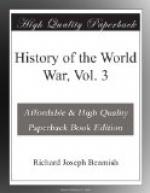While the German light forces and the first cruiser squadron under Vice Admiral Hipper were following the British, who were retiring north-westward, the German battle cruisers sighted to the westward Vice Admiral Beatty’s battle squadron of six ships, including four of the Lion type and two of the Indefatigable type. Beatty’s squadron developed a battle line on a southeasterly course and Vice Admiral Hipper formed his line ahead on the same general course and approached for a running fight. He opened fire at 5.49 o’clock in the afternoon with heavy artillery at a range of 13,000 meters against the superior enemy. The weather was clear and light, and the sea was light with a northwest wind.
After about a quarter
of an hour a violent explosion occurred on
the last cruiser of
the Indefatigable type. It was caused by a
heavy shell, and destroyed
the vessel.
About 6.20 o’clock in the afternoon five warships of the Queen Elizabeth type came from the west and joined the British battle cruiser line, powerfully reinforcing with their fifteen-inch guns the five British battle cruisers remaining after 6.20 o’clock. To equalize this superiority Vice Admiral Hipper ordered the destroyers to attack the enemy. The British destroyers and small cruisers interposed, and a bitter engagement at close range ensued, in the course of which a light cruiser participated.
The Germans lost two torpedo boats, the crews of which were rescued by sister ships under a heavy fire. Two British destroyers were sunk by artillery, and two others—the Nestor and Nomad—remained on the scene in a crippled condition. These later were destroyed by the main fleet after German torpedo boats had rescued all the survivors.
While this engagement
was in progress, a mighty explosion, caused
by a big shell, broke
the Queen Mary, the third ship in line,
asunder, at 6.30 o’clock.
Soon thereafter the German main battleship fleet was sighted to the southward, steering north. The hostile fast squadrons thereupon turned northward, closing the first part of the fight, which lasted about an hour.
The British retired at high speed before the German fleet, which followed closely. The German battle cruisers continued the artillery combat with increasing intensity, particularly with the division of the vessels of the Queen Elizabeth type, and in this the leading German battleship division participated intermittently. The hostile ships showed a desire to run in a flat curve ahead of the point of our line and to cross it.
At 7.45 o’clock in the evening British small cruisers and destroyers launched an attack against our battle cruisers, who avoided the torpedoes by manoeuvring, while the British battle cruisers retired from the engagement, in which they did not participate further as far as can




